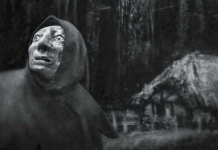Clickhole, the Onion’s answer to Buzzfeed and Clickhole, has posted an audacious NSFW video parody, “If You Grew Up With ‘Calvin and Hobbes,’ You Need to Watch This Now.” Spoilers below for those of you who aren’t already in custody haven’t seen it yet:
Clickhole’s video of Calvin and Hobbes having sex pretty much nukes anything an art critic has ever described as transgressive, but in so doing it also raises a serious legal concern. As you may recall, under 18 U.S. Code Sec. 1466A, U.S. law banning child pornography is not limited to visual depictions of real children. This has already led to prosecutions for possession of comics or cartoons – in fact, animated child sex is reportedly being used as, well, clickbait by law enforcement.
Could watching the Clickhole Calvin and Hobbes video get you sent to jail?
Let’s go exploring!
One key aspect of current U.S. law — setting aside other countries that may have more expansive prohibitions – is that it reflects an adaptive response to the Supreme Court’s conclusion that earlier versions were too broad in ways that violated the First Amendment. As a result Section 1466A only bans non-realistic visual depictions such as the Calvin and Hobbes video if they are obscene or lack serious artistic, literary, political or scientific value.
Here, in brief, is why Congress went with that language. In a series of decisions several decades ago, the Supreme Court came up with a standard for obscenity that, it believes, passes constitutional muster. The standard is known as the Miller test for determining obscenity, and it has three key components: the material appeals to prurient interest, is patently offensive and lacks serious literary, artistic, political or scientific value. By echoing this language, Congress hoped – and so far has mostly succeeded – in establishing a standard for visual depictions of minors in drawings, cartoons, sculptures or paintings that would survive a constitutional challenge.
1466A(a)(2) and (b)(2) ban, among other things, graphic images of a minor engaging in actual or simulated bestiality that lack serious artistic, literary, political or scientific value. Before we get to the question of value, it’s worth noting that the statute goes on to define “graphic” to refer to images in which “a viewer can observe any part of the genitals or pubic area of any depicted person or animal.” In essence, these sections take a shortcut past the prurient and patently offensive elements of the obscenity test, which are determined by community standards, by providing an absolute bright-line standard.
Watch the Clickhole Calvin and Hobbes video carefully and you’ll see that it arguably does not portray the genitals or pubic area of either character – the very sort of thing that a strategic company lawyer might tell a company producing such a video to do if it was determined to post it. That’s not a slam-dunk conclusion, though. Calvin is drawn in a way that resembles the iconic “Love Is …” one-panel cartoon, the product of a time before contemporary anti-child-porn laws as well as a strip that does not depict minors in sexual situations, at least in authorized versions.
Section 1466A(a)(1) and (b)(1) are somewhat more expansive. These provisions prohibit an obscene depiction of sexually explicit conduct, which extends to simulated bestiality and other sexual activity whether or not the genitals or pubic area appear.
What makes determining whether material is obscene particularly hard to determine is that the test looks to community standards – technically in regard to determining whether material appeals to the prurient interest or is patently offensive, but the community sensibility also tends to come into play in assessing whether a reasonable person would find that the material lacks socially redeeming value. This applies not only to a federal statute such as Section 1466A, but any state anti-obscenity or anti-child pornography laws under which the Calvin and Hobbes cartoon could be assessed.
This reliance on community standards has had the effect of balkanizing U.S. obscenity law. What is obscene in one jurisdiction can be perfectly legal in another. Case in point: the Christopher Handley case, which involved a manga collector. The Iowa district judge in that case concluded that 1466(a)(2) and (b)(2) are unconstitutional, but the 11th Circuit U.S. Court of Appeals, which covers Florida, Georgia, and Alabama, expressly disagreed.
In short, if the science of law is, to quote Oliver Wendell Holmes, an art of prediction, the current constitutional definition of obscenity is a Magic 8 Ball.
Which also brings us to 18 USC 2252C, a related provision that prohibits knowingly embedding words or digital images into the source code of a website with the intent (a) to deceive a person into viewing material constituting obscenity or (b) to deceive a minor into viewing material harmful to minors on the Internet. If one is dealing with a judge or jury likely to conclude that the Calvin and Hobbes cartoon is obscene, there is an equally significant risk of being found guilty of using misleading words (the clickbait headline) and images (the still frame before playing) to trick either an adult or a minor into clicking play.
So to answer the question of whether Clickhole’s Calvin and Hobbes Cartoon is illegal, I’d have to say it depends – on the jurisdiction, on the prosecutor, the judge, the jury and the case presented by the defendant’s lawyers. And again, the rest of the world is not bound by our First Amendment jurisprudence and its definition of obscene, so there could be a greater risk elsewhere. There’s a substantial possibility, of course, that nothing will ever happen to Clickhole or any viewers of this video, but it’s not a risk that many lawyers would want their clients to take.








Quite funny though wasn’t it?
isn’t anything intentionally subversive dealing with “serious literary, artistic, political or scientific value” by definition?
Jacob, the short answer is no. The determination is left up to a judge or jury, and depending on the locality you can get two wildly different outcomes.
Consider the Jesus Castillo case, in which a comic shop clerk in Texas was sentenced to jail + fined for selling manga, including the work of hentai pioneer Toshio Maeda. While Castillo was being tried in Dallas, Maeda was feted as guest of honor of the Big Apple Con in New York. Moreover, an expert from the University of Texas at Austin testified to the work’s value, which would have been a slam dunk for the defense in Austin but was a huuuuuuge mistake given Dallas culture, a good chunk of which essentially sees UT-Austin as the alma mater of the Antichrist.
I could cite other examples – the Mike Diana case is another big one – but I hope the risk is clear. The fact that it’s the Onion may make prosecution substantially less likely, but someone else posting the video might not have been so fortunate, especially in more conservative/religious jurisdictions.
Another hypothetical: imagine if someone were to print the scenes in a contemporary homage to a Tijuana Bible, with the same tag line and cover still, and give out copies for free to kids at playgrounds and parks in Alabama. Even if it’s an act of performance art aimed at challenging the sacredness of childhood in American culture, there’s danger, Will Robinson, to say the least.
well that’s depressing.
Obscenity laws are a joke and should be stricken from the record.
Child pornography laws should be restricted to ACTUAL child pornography.
Cartoons are not people and don’t need legal protection. Money ISN’T speech. yadda yadda yadda.
The judicial system is in the same shambles the other branches of government currently suffer from.
“Do what thou wilt shall be the whole of the law
Until you violate the rights of another”
Update: the piece in question has already been removed from Clickhole.
YouTube pulled the version posted there as a violation of their “policy on nudity or sexual content”. That’s the one linked to above.
However a version is still up and accesible via Digg.com at least as I type this.
If You Grew Up With ‘Calvin And Hobbes,’ You Need To Watch This Right Now – Digg
Using Calvin and Hobbes in this way is obviously going to push as many hot buttons as possible in the shortest time. Speaking as a C&H fan, I don’t myself see it as disrespectful to the characters (unlike other C&H fanfic I’ve seen) but I can perfectly understand other people feeling very differently.
However I’m afraid there’s something about this post I don’t much care for. In part that’s because it reminds me of Jeff Trexlers previous post
The Legal View: Wertham was right .
as an example of public advocacy for ‘responsible’ cartooning.
I hate to imagine what kind of legal “concern trolling” we would be seeing today if say the Zap crew were fifty years younger and posting on tumblr. What did you do in the culture wars, daddy-o?
“Do what thou wilt shall be the whole of the law
Until you violate the rights of another”
There are plenty of people who’ll say you’ve violated their rights just by existing.
“There are plenty of people who’ll say you’ve violated their rights just by existing.”
It’s not about what is said. It’s about what you can prove. People say lots of things. Unless you can prove harm has been done, then it gets tossed out.
It’s time to hit the reset button on the legal system. Too many laws are based on fear and actually violate the rights of individual liberty. Legalize Everything.
“and give out copies for free to kids at playgrounds and parks in Alabama. Even if it’s an act of performance art aimed at challenging the sacredness of childhood in American culture, there’s danger, Will Robinson, to say the least.”
The issue there would be that you are distributing to children, a law which (in general, at least) doesn’t have the same “performance art” exemption as the child porn law. I guess you could still argue performance art as a defense, but it wouldn’t actually be built in to the definition of the crime.
Sean, that was essentially the point I was making – to the eyes of certain prosecutors and folks in the general public, featuring a clickable image of Calvin and Hobbes or feature still of Calvin and Hobbes, along with the misleading headline with no warning of adult content, would be the digital equivalent of targeting kids in the physical world. It’s the same argument that was made against Joe Camel + other cartoons in cigarette advertising, not to mention obscenity/child porn cases in which the mere fact that material is a comic book is irrefutable evidence that the material was marketed to kids.
Again — and this is relevant to Dave’s concern about concern trolling – identifying an issue or effect is not inherently an endorsement of all responses to it. The Clickhole article wasn’t a “think about the children” piece – it flagged legal issues raised by the video. In the corporate world, that’s not concern trolling – it’s doing your job.
If there was any concern there, it was for folks who confuse ought for is when it comes to the arguments made by free speech advocates re the unconstitutionality of current law. When the Supreme Court is repeatedly declining to review the appeals of people who have been sent to prison for reading comics or watching cartoons, buying into the groupthink that there is little-to-no risk in fictional images can be dangerous, especially if you live in certain areas or are the owner of a comic shop.
My Wertham piece was not what some people might think it is just by looking at the admittedly provocative title. Again, I’m writing primarily as a tactician – strawmanning Wertham may feel good, but it is useless for winning battles in a war that free speech advocates are losing to an alarming degree. We lose strategically useful insight when we celebrate our superiority over a guy who trained a hundred years ago — the other side didn’t stop thinking after Kefauver, so why should we?
Comments are closed.